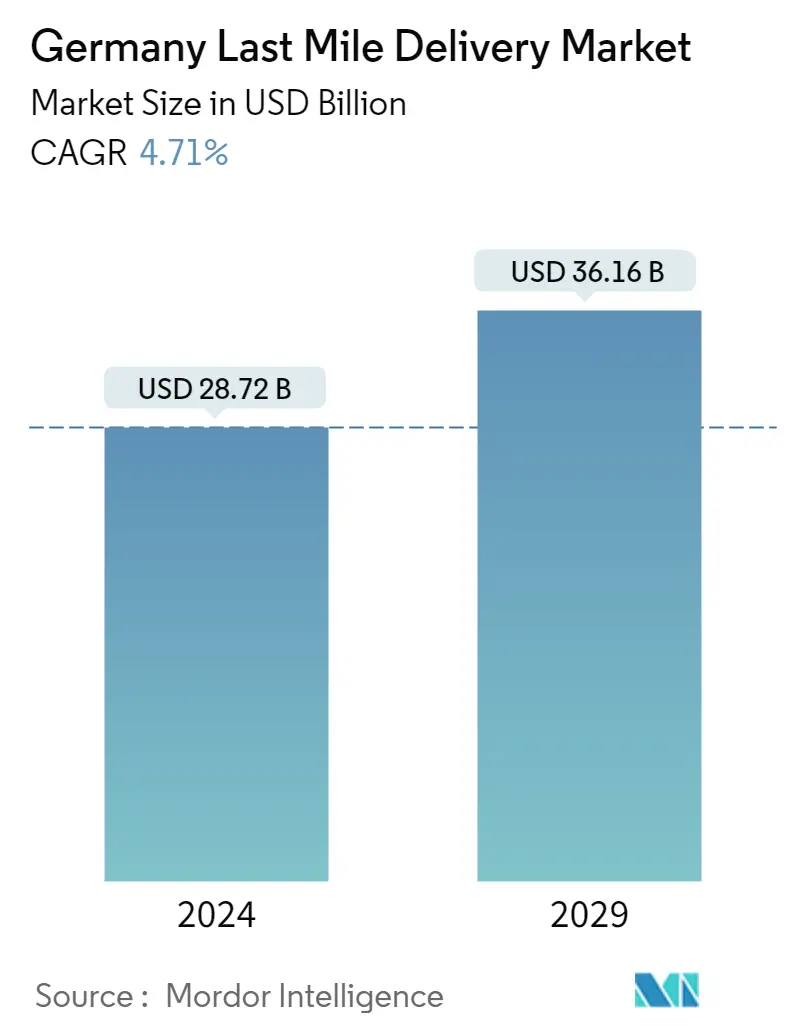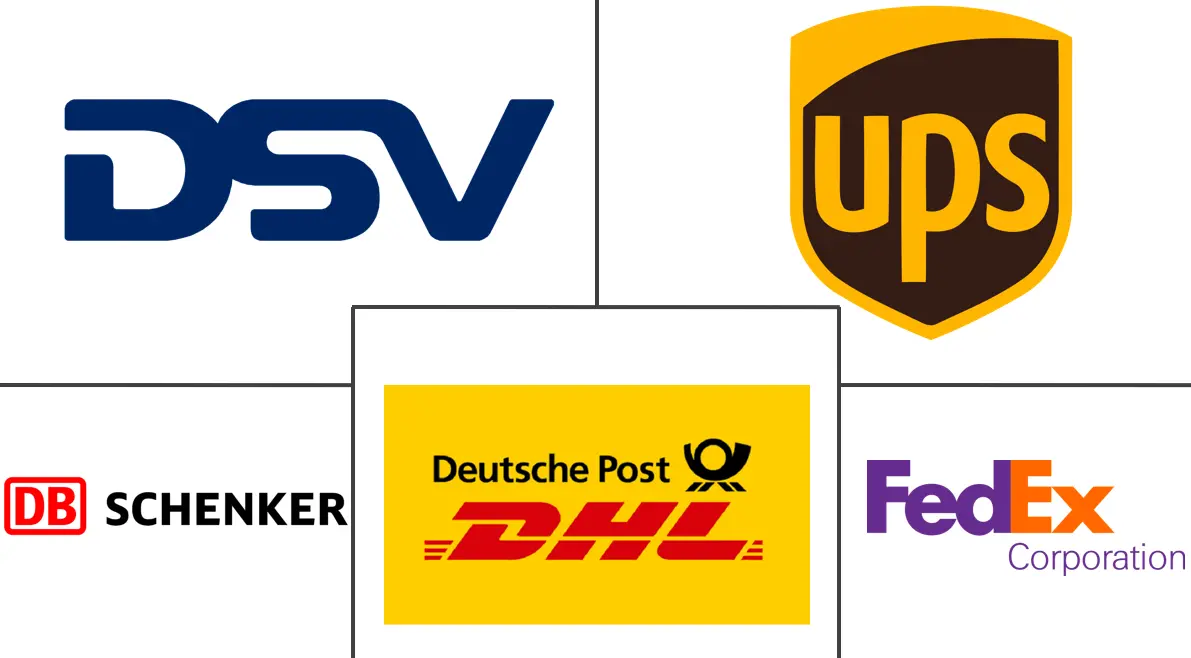Market Size of Germany Last Mile Delivery Industry

| Study Period | 2020 - 2029 |
| Base Year For Estimation | 2023 |
| Market Size (2024) | USD 28.72 Billion |
| Market Size (2029) | USD 36.16 Billion |
| CAGR (2024 - 2029) | 4.71 % |
| Market Concentration | Low |
Major Players
*Disclaimer: Major Players sorted in no particular order |
Germany Last Mile Delivery Market Analysis
The Germany Last Mile Delivery Market size is estimated at USD 28.72 billion in 2024, and is expected to reach USD 36.16 billion by 2029, growing at a CAGR of 4.71% during the forecast period (2024-2029).
The mile delivery market is driven by several factors, including the development of the e-commerce sector and the rise in trading activities due to globalization, technological innovations in delivery vehicles, and the need for fast package delivery.
However, poor infrastructure, high logistics costs, a lack of control over logistics services by manufacturers and retailers, and an inaccurate postal address system will impede the market growth. Since the implementation of the directive to restrict social activities and non-essential commercial activities in Germany, freight transport by rail and road has decreased by approximately 20%.
The majority of online retailers were also affected by COVID-19. According to Deutsche Post, a daily average of 5.2 million parcels are usually delivered. Deutsche Post reported that during the lockdowns, more than 8 million packages and deliveries were transported daily. The coronavirus crisis has led to an increase in the demand for storage space in the country, which is not unexpected.
Germany has seen unprecedented growth in e-commerce, as has almost every country in the world. In parallel with the growth of e-commerce, nationwide out-of-the-home delivery options such as parcel lockers and parcel collection stations have become increasingly popular. Deutsche Post, for example, currently operates about 8500 automated parcel machines, with plans to increase that to 12,500 machines by 2023.
For instance, in June 2023, DODO, the same-day delivery service provider, expanded its operations into the German market, reinforcing the long-term viability of same-day, last-mile delivery. DODO has developed a comprehensive software and delivery ecosystem over the years to support players across a variety of industries. This ecosystem is further supported by the company's white-label solution, which allows direct integration into the company's IT structure. DODO currently employs more than 2500 couriers and 1,000 vehicles.
Germany Last Mile Delivery Industry Segmentation
The transit of goods from a transportation hub to the last delivery destination is known as last-mile delivery. Last-mile delivery focuses on getting things to the final user as quickly as possible. A complete assessment of Germany's Last Mile Delivery Market includes an overview of the economy market, market size estimation for key segments, and emerging trends in the market segments in the report. The report sheds light on the market trends like growth factors, restraints, and opportunities in this sector. The competitive landscape of Germany's Last Mile Delivery Market is depicted through the profiles of active key players. The report also covers the impact of COVID–19 on the market and future projections.
The Germany Last-Mile Delivery Market report is segmented by Service (B2B (Business-to-Business), B2C (Business-to-Consumer), and C2C (Customer-to-Customer)). The report offers the market size in value terms in USD for all the abovementioned segments.
| By Service | |
| B2B (Business-to-Business) | |
| B2C (Business-to-Consumer) | |
| C2C (Customer-to-Customer) |
Germany Last Mile Delivery Market Size Summary
The Germany Last Mile Delivery Market is poised for significant growth, driven by the burgeoning e-commerce sector and increased trading activities fueled by globalization. Technological advancements in delivery vehicles and the demand for rapid package delivery are key factors propelling the market forward. However, challenges such as inadequate infrastructure, high logistics costs, and issues with postal address accuracy pose obstacles to growth. The COVID-19 pandemic has further complicated the landscape, with a notable increase in package deliveries during lockdowns, highlighting the need for expanded storage and delivery solutions. The rise of out-of-home delivery options, such as parcel lockers and collection stations, reflects the evolving consumer preferences and the market's adaptation to new demands.
The competitive landscape of Germany's Last Mile Delivery Market is characterized by a mix of international and domestic players, including prominent companies like DSV, UPS, DB Schenker, Deutsche Post DHL, and FedEx. These companies are increasingly integrating new technologies such as drones, e-vehicles, and artificial intelligence to enhance their service offerings. Despite the competitive environment, the market faces challenges related to rising labor costs and decreasing labor availability. Infrastructure investments, such as the expansion of transport networks and the development of smart traffic management systems, are crucial for improving logistical efficiency and reducing delivery times. The government's commitment to increasing transport infrastructure spending further supports the market's growth prospects.
Germany Last Mile Delivery Market Size - Table of Contents
-
1. MARKET INSIGHTS
-
1.1 Current Market Scenario
-
1.2 Technological Trends
-
1.3 Insights into E-Commerce Industry
-
1.4 Insights into Trucking Industry
-
1.5 Insights into Warehousing and Distribution Centers
-
1.6 Insights into Refrigerated Last Mile Delivery
-
1.7 Insights into Return Logistics
-
1.8 Impact of COVID-19 on the Market
-
-
2. MARKET SEGMENTATION
-
2.1 By Service
-
2.1.1 B2B (Business-to-Business)
-
2.1.2 B2C (Business-to-Consumer)
-
2.1.3 C2C (Customer-to-Customer)
-
-
Germany Last Mile Delivery Market Size FAQs
How big is the Germany Last Mile Delivery Market?
The Germany Last Mile Delivery Market size is expected to reach USD 28.72 billion in 2024 and grow at a CAGR of 4.71% to reach USD 36.16 billion by 2029.
What is the current Germany Last Mile Delivery Market size?
In 2024, the Germany Last Mile Delivery Market size is expected to reach USD 28.72 billion.

